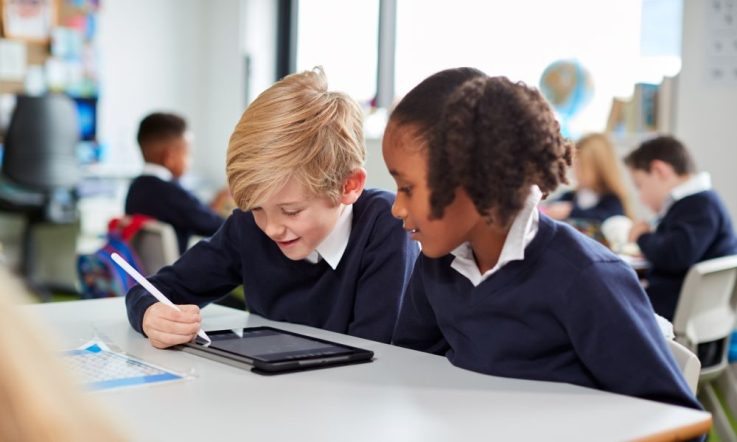The rapid adoption of digital technologies in schools has dramatically changed the way schools and classrooms look, teachers work and students learn. In a 3-part series on technology in education, Dr Ralph Saubern, Deputy CEO of the Australian Council for Educational Research, explores whether the integration of technology in schools has led to improved outcomes for learners. He also looks at how schools and teachers can choose the right EdTech in the first place, and he addresses the challenges and opportunities in evaluating the impact of EdTech on learning outcomes. Here in part 1, Dr Saubern shares an example of how a middle school English Professional Learning Community designed a 4-step progression that describes the development of teachers’ understanding of using technology to support students’ text analysis skills.
Digital technology is everywhere in the classrooms of today; laptops and tablets are on every student and teacher desk; and lessons are increasingly shaped by the use of digital tools and platforms.
While many digital innovations have great promise, there is little strong evidence to date that the adoption of these technologies has led to broad improvements in student learning, engagement, wellbeing, or even efficiency – the things by which we usually evaluate the success of schooling.
For many teachers, these shifts have brought real challenges – new tools, new skills, new expectations, and often little support. Some years ago, I was working with a school to support their development of a digital technology approach. One of the teachers, an experienced and effective educator, eyed me at one point and said, ‘Is this another thing we have to learn?’
TPACK – teaching teachers to teach with technology
Back in the 1990s, teacher educators began to understand that new teachers would be going out into a world in which digital technologies would be an inherent part of teaching practice. They challenged the idea of teaching technology skills to teachers in separate courses. Instead, they argued that technology skills should be taught in an integrated way, alongside learning pedagogy and content. This integrated approach became known as the Technological Pedagogical and Content Knowledge (TPACK) Framework.
TPACK is a form of professional knowledge that teachers need to develop. It is different from technology knowledge; it is the knowledge that teachers need to use technology in ways that support a pedagogical approach to teaching content. For the last 20 years, teacher educators and researchers have used TPACK to improve teacher education programs, build professional capability, and research teaching and learning’s use of technology.
Where’s the learning?
It is impossible to calculate exactly how much money has been spent on the adoption of digital technologies in Australian schools over the last decade or so, but it is in the billions. The enthusiasm for technology in many school systems around the world is largely based on the premise that it is modern, forward looking and will improve education and outcomes for learners.
But there’s a problem – there is little evidence from large scale global studies, systematic reviews and meta-analyses of research that the integration of technology in schools has led to improved outcomes for learners. For students using $1000 laptops in a classroom with a $15,000 interactive whiteboard, simply having access to this technology does not mean they will develop writing, mathematics or science skills any faster than those who only have access to a $5 notepad and $50 blackboard.
Researchers reviewing large scale studies of student learning have concluded that, at best, technology integration in schools has had a modest effect on learning outcomes (Falck et al., 2018). A recent study of 23 countries found that technology adoption was not even associated with improved efficiency (Mergoni et al., 2023).
So, what’s going on? We have a good, evidence-based understanding of what works in education and, on the face of it, educational technologies have many of the features and qualities that should support and magnify those approaches: feedback, personalised learning, formative assessment, and more.
A developmental approach
One thing that we do know from the research is that the biggest influence on student learning is their teacher. As John Hattie put it, what teachers ‘know, do and care about’ (Hattie, 2003) really matters when it comes to learning – and that leads us back to TPACK.
While TPACK has been a very popular approach in teacher education and research, it is disappointing that this improved way of thinking about preparing teachers to teach with technology hasn’t shown more impact on teacher practice and student learning outcomes. In my PhD research, I tackled this problem by exploring a new way of thinking about TPACK.
If teacher educators thought about TPACK in a developmental way – closely linked to curriculum goals and student learning outcomes – it could help focus teachers on the things they needed to learn in order to use technology more effectively for teaching. Teachers (and teacher educators) could more easily see what skills, understandings and attitudes they needed to develop to reach their goals and would have a ‘roadmap’ to get there.
An explicit improvement agenda – an example
Let’s take a hypothetical middle school English Professional Learning Community (PLC) who identified a broad goal of improving students’ text analysis skills. The PLC works together to consider how technology can help teachers drive this learning goal.
Thinking about the technology available, the school’s general pedagogical approach, and the content of the year’s middle school English curriculum, the PLC developed a 4-step progression that describes the development of teachers’ understanding of using technology to support students’ text analysis skills.
- Level 0 is no technology: Teachers don’t understand how to use technology to support students’ development of text analysis skills.
- Level 1 is Teachers understand how to use technology to model text analysis techniques. That might be using a PowerPoint presentation or an interactive whiteboard to run through a typical text analysis process.
- Level 2 is where teachers start to understand how to integrate the technology into the teaching and learning process itself, with teachers mainly in control of the technology. Teachers understand how to integrate technology to provide structured, teacher-mediated opportunities for students to analyse texts.
- In Level 3, the final, most sophisticated level, teachers give more control of the technology to students, and it is students who drive the technology use and the learning opportunities. ‘Teachers understand how to integrate technology to provide students opportunities to practice and develop text analysis skills in open-ended tasks and in collaboration with peers.’
| Level 3 | Teachers understand how to integrate technology to provide students opportunities to practice and develop text analysis skills in open-ended tasks and in collaboration with peers. |
| Level 2 | Teachers understand how to integrate technology to provide structured, teacher-mediated opportunities for students to analyse texts. |
| Level 1 | Teachers understand how to use technology to model text analysis techniques |
| Level 0 | Teachers don’t understand how to use technology to support students’ development of text analysis skills. |
Figure 1: A progression for ‘analyse texts’
At the start of the school year, alongside these general descriptions, the teachers workshop a whole series of examples of practices relating to the middle school curriculum using the school’s available technology. Throughout Term 1 and 2, the PLC focuses on supporting teachers to develop an increasingly sophisticated understanding of tools, curriculum goals and learning outcomes. The PLC monitors student learning growth and thinks about how this relates to teaching practices with technology.
At the start of Term 3, the PLC meets again and workshops a progression for another key learning improvement goal: improving students’ ability to communicate ideas to an audience.
At the end of the year in Term 4, the PLC reviews the ‘analyse texts’ and ‘communicate ideas’ progressions with lessons learned, including the impact on student learning outcomes, and new ideas developed. An explicit and outcomes-focused professional development program has been developed.
Stay tuned: In part 2 of this 3-part series on technology in education, Dr Ralph Saubern explores how schools and teachers can choose the right EdTech in the first place.
All articles in this series:
- Part 1: EdTech and teachers: Integrating technology to improve student learning
- Part 2: A learning-first approach to EdTech
- Part 3: The opportunities and challenges of evaluating EdTech
References
Falck, O., Mang, C., & Woessman, L. (2018). Virtually no effect? Different uses of classroom computers and their effect on student achievement. Oxford Bulletin of Economics and Statistics, 80(1), 1–38.
Mergoni, A., Sonchin, M., & Agasisti, T. (2023). The effect ICT on schools’ efficiency: Empirical evidence on 23 European countries. Omega, 119, 102891.
Hattie, J. (2003). Teachers make a difference: What is the research evidence? Research Conference 2003: Building teacher quality. Australian Council for Educational Research.
As a PLC leader, how are you supporting new and existing staff in developing the skills they need to use technology to improve student learning?
As a teacher, when thinking about your own practice, are you and your colleagues making the best use of technology available to you? How could you go about improving the way you work with technology in your classroom?



